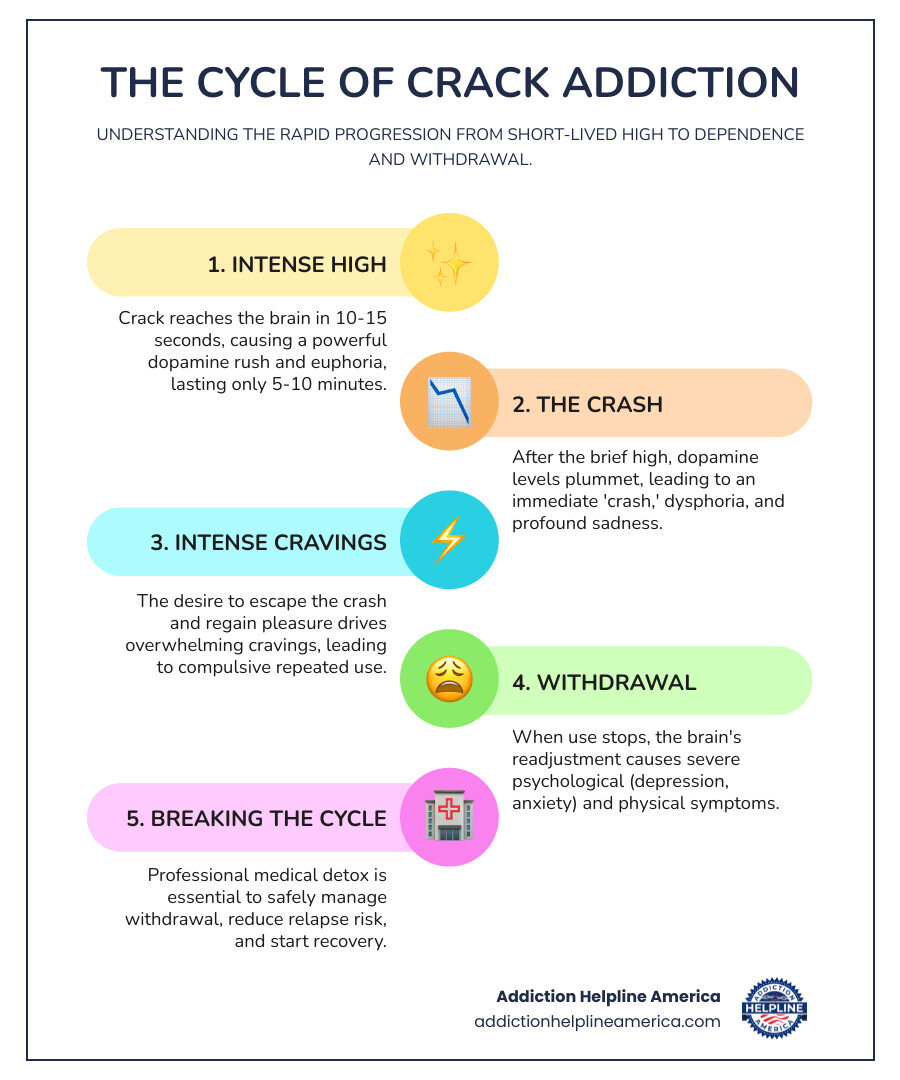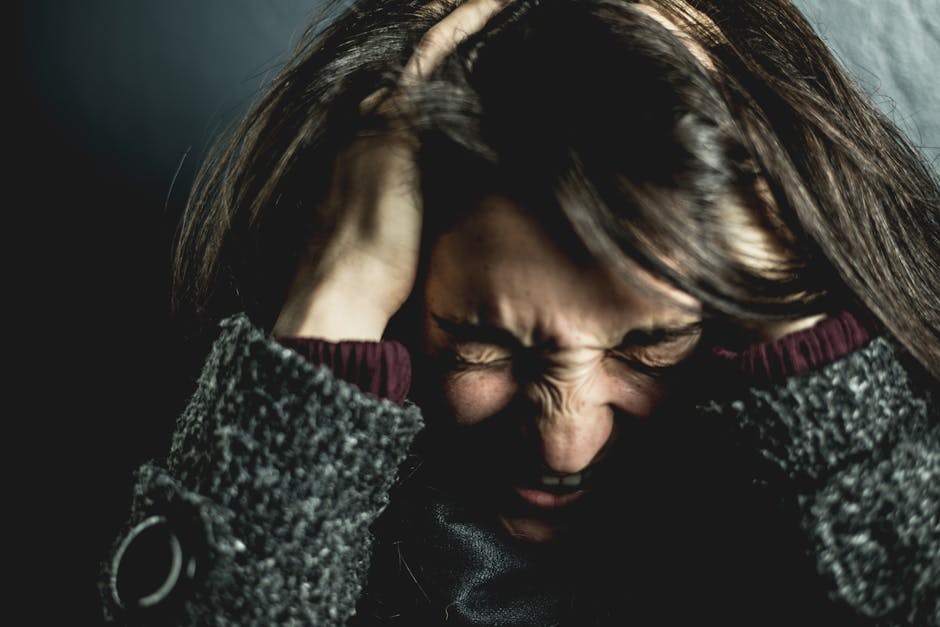Your Journey to a Healthier Life Starts Here
Free Insurance Verification
Verify Your Treatment Coverage
Verify Your Treatment Coverage
Crack Detox is the process of safely removing crack cocaine from your body while managing withdrawal symptoms under medical supervision. For anyone struggling with crack addiction, understanding detox is the crucial first step toward recovery.
What You Need to Know About Crack Detox:
Crack cocaine’s intense, short-lived high (5-10 minutes) creates a vicious cycle of repeated use and rapid dependence. When you stop, your body and brain must readjust—a process called withdrawal. Detox is the medically supervised process that helps you safely manage this transition.
The psychological grip of crack is powerful. Your brain becomes dependent on the drug for dopamine (the pleasure chemical), leading to severe depression and overwhelming cravings when you stop. This makes relapse extremely likely without professional support.
This guide covers what happens during withdrawal, why medical supervision is critical, available treatment options, and how to find support. At Addiction Helpline America, we connect people to compassionate, evidence-based treatment options. Our team is here 24/7 to provide the guidance you need.

Regular crack cocaine use fundamentally changes your brain chemistry. Your body adapts to the drug, creating a powerful physical and psychological dependence. Crack floods the brain with dopamine, the pleasure chemical. Over time, your brain reduces its natural dopamine production, becoming dependent on the drug just to feel normal. This disruption makes crack detox challenging, often more severe than withdrawal from powder cocaine due to crack’s potency and rapid effects.

Take the first step towards a healthier life! Call now to connect with our compassionate team and start your recovery journey today. Your path to healing awaits!
Our recovery specialists are available 24/7 to provide support, and all calls are confidential and free. Reach out anytime – we’re here to help!

Withdrawal from crack affects both mind and body, and the psychological effects are often the most distressing and dangerous. This is why medically supervised crack detox is essential.
Psychological Symptoms:
Physical Symptoms:
The crack withdrawal timeline varies based on usage history, metabolism, and overall health, but a general pattern exists.
Trying to quit crack cocaine “cold turkey” is not only difficult but also dangerous. The intense psychological symptoms and powerful cravings create a high risk for relapse. After even a short period of abstinence, your body’s tolerance to the drug drops, meaning a relapse with the same amount you used before can lead to a serious overdose.
This is why crack detox under medical supervision can be lifesaving.
While crack withdrawal itself isn’t typically fatal like alcohol withdrawal, its side effects can create life-threatening situations.
Psychological dangers are the most significant risk. Severe depression combined with an inability to feel pleasure can lead to suicidal thoughts. Without professional intervention, the risk of self-harm is dangerously high. Psychosis and paranoia can also cause erratic, unsafe behavior.
Physical complications can be serious. Crack strains the cardiovascular system, and withdrawal can cause unpredictable changes in heart rate and blood pressure, leading to cardiac events. Dehydration, malnutrition, and, in rare cases, seizures can also occur.
Co-occurring mental health disorders add another layer of danger. As noted in government statistics, addiction and mental health are often linked. Withdrawal can worsen conditions like anxiety or depression, making dual diagnosis treatment essential for a safe detox.
In short, professional help is essential because crack withdrawal can lead to life-threatening medical and psychological crises.
A medically supervised crack detox provides a necessary safety net during this vulnerable time. Here’s why:
Professional crack detox transforms a dangerous, isolating experience into a supported, medically managed process that offers a real chance at recovery. At Addiction Helpline America, we can help you find the right level of care.
Crack detox is the essential first step, but it’s only the beginning. Lasting recovery requires a comprehensive treatment plan that addresses the psychological, emotional, and behavioral patterns behind the addiction. The most effective plans are individualized to your unique needs.
While there are no FDA-approved medications specifically for crack cocaine addiction, medical professionals can prescribe existing medications “off-label” to manage withdrawal symptoms and cravings. This approach can significantly improve comfort and success rates.
For example, Baclofen, a muscle relaxer, has shown promise in reducing cravings. Doctors may also prescribe antidepressants for severe depression, anti-anxiety medications for panic, or sedatives for insomnia. Other medications like Nifedipine, Tiagabine, or Gabapentin may be used to manage related symptoms. These medications are valuable tools used under careful medical supervision to stabilize you for the therapeutic work of recovery.
Therapy is the cornerstone of long-term recovery, helping you address the root causes of addiction. Several therapeutic approaches are effective:
Therapy equips you with essential relapse prevention skills, teaching you to identify triggers, manage stress, and build a toolkit of healthy coping mechanisms.
After crack detox, you’ll transition to ongoing treatment. The right level of care depends on your specific needs, addiction severity, and home environment.
At Addiction Helpline America, we help you determine the right combination of treatment options for your unique journey.
When considering crack detox, you likely have pressing questions. Here are clear answers to the most common concerns.
The duration of crack withdrawal varies depending on factors like usage history, metabolism, and overall health.
No, detoxing from crack at home is not recommended. While not always directly fatal like alcohol withdrawal, it carries significant risks:
A medically supervised crack detox provides 24/7 monitoring, symptom management, and a safe, trigger-free environment. It is the safest and most effective way to begin recovery.
Supporting a loved one through crack withdrawal is challenging. Here are key ways to help:

Take the first step towards a healthier life! Call now to connect with our compassionate team and start your recovery journey today. Your path to healing awaits!
Our recovery specialists are available 24/7 to provide support, and all calls are confidential and free. Reach out anytime – we’re here to help!

Understanding the crack detox process is a courageous first step toward recovery for yourself or a loved one. Recovery is a journey, not a destination. It requires patience and professional guidance, but a drug-free life is within reach.
Crack detox is the critical starting point that clears the drug from your body under safe, medical supervision. It helps you manage the intense physical and psychological withdrawal symptoms. While challenging, you do not have to go through it alone.
However, detox is only the beginning. Lasting sobriety is built through comprehensive treatment—including therapy, support groups, and lifestyle changes—that addresses the root causes of addiction. This is how you learn to cope with life’s challenges and build a hopeful future. We’ve seen countless people who felt hopeless find their way back to a life of purpose and connection.
At Addiction Helpline America, we know that starting can feel overwhelming. Our team offers free and confidential guidance 24/7. We provide personalized treatment matching, connecting you to the right addiction and mental health centers based on your unique needs.
You don’t have to figure this out alone. There is hope for a drug-free future—one where you can feel joy, reconnect with loved ones, and be proud of the person you are. That life is waiting. Take the first step.
Are you or a loved one struggling with addiction? Call today to speak to a treatment expert.
Calls to any general helpline will be answered or returned by one of the treatment providers listed, each of which is a paid advertiser:
Our helpline is available 24 hours a day, 7 days a week at no cost to you and with no obligation for you to enter into treatment. We are committed to providing support and guidance whenever you need it.
In some cases, Addiction Helpline America charges our verified partner a modest cost per call. This fee helps us cover the costs of building and maintaining our website, ensuring that we can continue to offer this valuable service to those in need.
Calls to the general helpline will be answered or returned by one of the listed treatment providers, all of whom are paid advertisers.
By using the helpline, you agree to the terms of use. We do not earn any commission or fee based on the treatment provider selected by the caller, and there is no obligation to pursue treatment.
This service is not affiliated with Alcoholics Anonymous World Services, Inc.